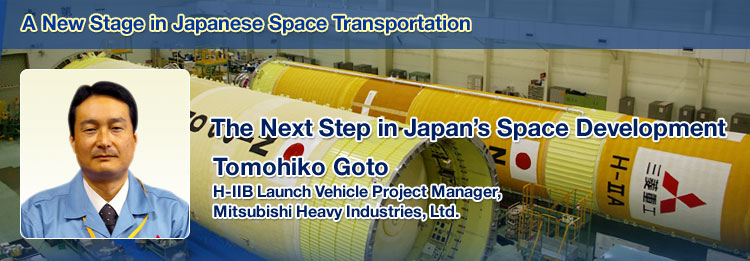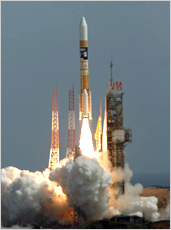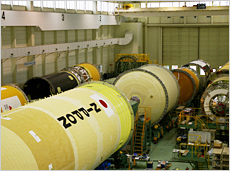

H-IIB first-stage liquid hydrogen tank
Japan's current launch vehicle, the H-IIA, was developed by Mitsubishi Heavy Industries Ltd. (MHI) under contract from JAXA. The new H-IIB launch vehicle, by contrast, is being developed as a partnership between JAXA and MHI. JAXA is responsible for the basic configuration, the first-stage firing tests of the clustering engines, and the total vehicle system verification tests at the launch site. Meanwhile, MHI is responsible for the detailed design and manufacturing of the flight test vehicle, and the ground verification tests.
The H-IIB is the first time JAXA and MHI have developed a launch vehicle jointly. Development tasks are divided between JAXA and MHI, with JAXA in charge of developing cutting-edge technology such as engine clustering, and MHI developing the manufacturing technology to fabricate the large-diameter propellant tank. The H-IIB will be the first Japanese launch vehicle to use clustered engines. I hope our partnership will bring our different strengths together so that we can move forward in the development process as efficiently as possible.

MHI's first H-IIA launch after taking over launch operations from JAXA, September 14, 2007
At present, our launch service uses only the H-IIA launch vehicle, but in the future, we would like to further improve our launch reliability and enter the international market with the H-IIB. Unlike the H-IIA, the H-IIB is capable of launching dual 2- to 4-tonne geostationary satellites at one time, which is a great cost saving over two separate H-IIA flights. This will help reduce the overall cost of satellite projects, which makes the H-IIB a strong commercial asset.

H-IIA and H-IIB rockets in parallel production
We are making progress with the H-IIB project based on a solid relationship of trust with JAXA. With that always in mind, we are making efforts to ensure fluid information sharing, for example with weekly progress meetings. When a problem comes up, it is openly discussed and resolved with a solution agreeable to both sides.
The H-IIB is the first joint development project between JAXA and MHI. Before this project, typically, JAXA did the research and development, then MHI was entrusted with the design, development and manufacturing. For the H-IIB project, however, JAXA is responsible for the basic configuration, and MHI handles the details. With this wider range of tasks, we have a lot more responsibilities and pressure. Having said that, no matter how responsibilities may change, our desire to give our absolute best for launch-vehicle development and production remains the same.
The first H-IIB launch vehicle will be shipped to the Tanegashima Space Center in early 2009, so we are currently very busy with its manufacturing. In the meantime, the H-IIA is also in production, so our factory has been fully occupied with launch vehicles. Increasing production means more investment in facilities, which will need updating, maintenance and replacement. I hope that JAXA will continue its efforts to maintain and even expand, Japan's space industry.

MHI is manufacturing the H-IIB launch vehicle and the H-II Transfer Vehicle (HTV) - our first attempt to build both a launch vehicle and its payload. In 2010, NASA's space shuttle is scheduled to retire, so we feel a great sense of responsibility to complete the HTV as an essential vehicle to transport materials to the International Space Station (ISS). Pairing up with JAXA, we are determined to make the first launch of the H-IIB and the HTV a success.
Space development requires high reliability supported by advanced technology, which is expensive. However, having its own launch vehicle will give Japan a strong sense of security and independence. I believe this is a very important asset for a developed nation. Japan's Basic Space Law was enacted in 2008. I would like space development to become one of the major pillars of our national strategy. I expect that the government will set a path for us, with such projects as the development of advanced rockets to carry heavier payloads, and the expansion of space activities on the ISS, and I hope we will be able to use our knowledge and skills to make these projects a success. I believe that these kinds of assignments will continue and even increase in years to come, and I would like to reinforce and facilitate such development with a successful launch of the H-IIB in 2009.
Tomohiko Goto
Deputy Director, Space System Engineering Department and Launch Services Department, H-IIB Launch Vehicle Project Manager, Mitsubishi Heavy Industries, Ltd.
Mr. Goto completed his studies at the Graduate School of Engineering, Hiroshima University, in 1983, and joined Mitsubishi Heavy Industries, Ltd. He has since been engaged in the design and development of rockets, as well as the Japanese Experiment Module Kibo for the ISS.
Deputy Director, Space System Engineering Department and Launch Services Department, H-IIB Launch Vehicle Project Manager, Mitsubishi Heavy Industries, Ltd.
Mr. Goto completed his studies at the Graduate School of Engineering, Hiroshima University, in 1983, and joined Mitsubishi Heavy Industries, Ltd. He has since been engaged in the design and development of rockets, as well as the Japanese Experiment Module Kibo for the ISS.
The H-IIB Launches a New Rocket Era in Japan
H-IIB Launch Vehicle: Designed for World-Class Launch Capability
The Next Step in Japan's Space Development
HTV: An Indispensable Part of ISS Operations
H-IIB Launch Vehicle: Designed for World-Class Launch Capability
The Next Step in Japan's Space Development
HTV: An Indispensable Part of ISS Operations